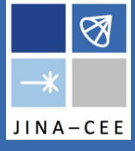Speaker
Dr
Gen Chiaki
(Gergia Tech)
Description
Metal-poor stars are living fossils with records of the nucleosyntheses in the early Universe. In particular, extremely metal-poor (EMP) stars are considered to be born in gas clouds having enriched by a single or several supernovae (SNe) of first metal-free (Pop III) stars, and thus we can indirectly constrain the properties of Pop III SNe from the metal content and elemental abundance ratio of EMP stars. To investigate the enrichment process of EMP star forming region, we perform numerical simulations of the feedback effects of photoionization and SNe of Pop III stars with a range of masses of Pop III stars and minihalos (MHs). For a pair-instability supernova (PISN) with large explosion energy $\sim 30\times 10^{51}$ erg, the ejected gas reaches to the neighboring halos, i.e., external enrichment (EE) takes place in all relevant mass range of MHs ($3\times 10^{5}$-$3\times 10^{6} M_{\odot}$). Yet, the metals can not penetrate into the central part of halos, and the resulting metallicity is $< 10^{-5} Z_{\odot}$. This is consistent with no observational signs of PISNe among EMP stars. For a core-collapse supernov (CCSN) with normal explosion energy $\sim 1\times 10^{51}$ erg, the ejected gas falls back into the MH and internal enrichment (IE) occurs. The metallicities in the recollapsing region are $10^{-5}$-$10^{-3} Z_{\odot}$ in most cases. We can conclude that IE by CCSNe can explain the metallicity range and elemental abundance ratio of EMP stars.
Primary author
Dr
Gen Chiaki
(Gergia Tech)
Co-authors
Prof.
Hajime Susa
(Konan University)
Dr
Shingo Hirano
(Texas University)
